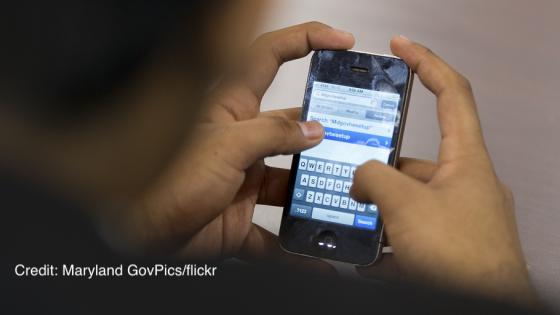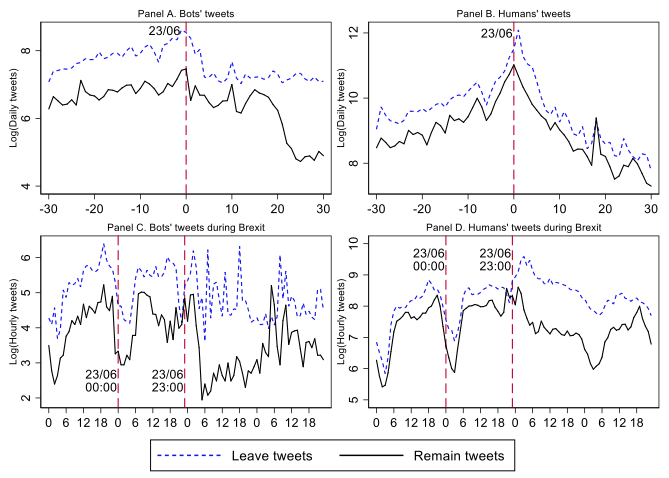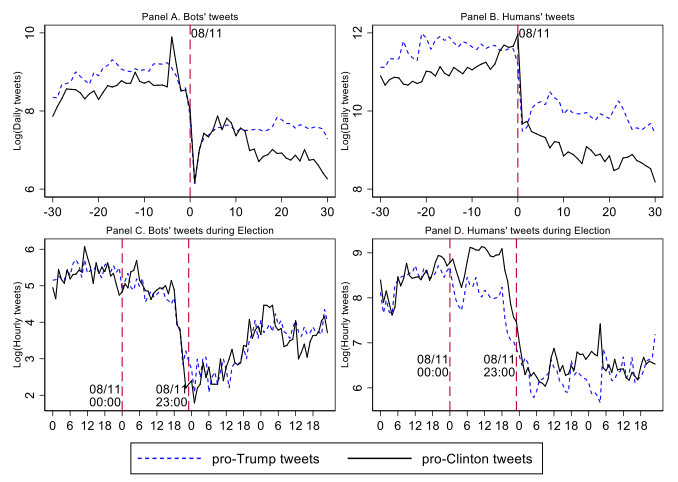Recent years have witnessed a dramatic change in the way people communicate and obtain information. Consumption of traditional news media is declining (Stempel et al. 2000) while online media has become an increasingly important source of information (Bialik and Matsa 2017). The key questions are how this communication revolution has influenced information flows across individuals and how one can influence these flows.
In a recent study (Gorodnichenko et al. 2018), we examine information diffusion in social media during high-impact events using Twitter data related to the EU referendum in the UK (‘Brexit’) and the 2016 US presidential election. We identify two types of social media agents: real (‘human’) users and social bots (computer algorithms used to produce automated content). We consider these bots as a source of variation in humans’ information sets and study how this information influences humans, how it is spread across humans, and how the sentiment (tonality) of bots’ messages affect humans.
The use of Twitter to share information about Brexit and the US election
Figure 1 presents the evolution in the daily and hourly volumes of Brexit-related tweets for humans and bots. There was a significant increase in the number of tweets created by humans on 23 and 24 June 2016. However, the volume of tweets created by bots, although relatively high, was more stable. Interestingly, the daily volume of pro-leave tweets was always higher than the daily volume of pro-remain tweets. This gap was greatest at 00:00 and 06:00 on 24 June, with a peak of about 10,000 tweets. There is a clear pattern in humans’ hourly tweeting volume. Human accounts are more active between 6 am and 6 pm and they show considerably smaller intensity in other hours. In contrast, we do not observe any clear pattern in the hour-by-hour tweeting activity of bots.
The daily and hourly volumes of tweets related to the 2016 US election are shown in Figure 2. Most of the time, the daily number of pro-Trump tweets exceeded that of pro-Clinton tweets. A large-scale increase in pro-Clinton tweets only appeared shortly before the election day. About five days before and on the election day, the number of pro-Clinton tweets soared with a peak of nearly 10,000 tweets per hour and was higher than the number of pro-Trump tweets. Comparing the differences in the number of tweets created by the two sides before and after the voting day, we observe a significant decline in the hour-by-hour gap between the two periods.
Figure 1 Dynamics of Brexit-related tweets generated by humans and bots
Notes: This figure shows the dynamics of tweets created by bots (Panels A and C) and humans (Panels B and D) for the Brexit sample. Time (horizontal axis) in Panels A and B refers to 30 days before and after the referendum day while time (horizontal axis) in Panels C and D presents hours of days around the event. The dashed blue line and the solid black line show the volumes of pro-leave and pro-remain tweets, respectively.
Figure 2 Dynamics of tweets related to the 2016 US presidential election generated by humans and bots
Notes: This figure shows the dynamics of tweets created by bots (Panels A and C) and humans (Panels B and D) for the US election sample. Time (horizontal axis) in Panels A and B refers to 30 days before and after the election day while time (horizontal axis) in Panels C and D presents hours of days around the event. The dashed blue line and the solid black line show the volumes of pro-Trump and pro-Clinton tweets, respectively.
Interaction across bots and humans in spreading information
In our empirical analysis, we use the unique properties of Twitter as well as standard tools of time series analysis to study the interaction across Twitter agents with different views in spreading information. We find evidence consistent with the low information rigidity and/or the short-lived news cycles in social media. Specifically, information about Brexit and the 2016 US presidential election is disseminated and absorbed among Twitter users within 50-70 minutes. However, the degree of interaction across different user types is variable. For instance, Remain supporters in the EU referendum respond more strongly and faster to messages created by other Remain supporters as compared to messages from Leave supporters. This pattern is consistent with the view that social media creates ‘echo chambers’.
We also observe the considerable impact of bots on human tweeting activity. The degree of influence depends on whether a bot provides information consistent with a human’s priors. For example, a bot supporting the Leave campaign has a stronger impact on a Leave supporter than on a Remain supporter. Similarly, Trump supporters are more likely to react to messages spread by pro-Trump bots. Further examination shows that the sentiment of tweets plays an important role in how information is spread – a message with positive (negative) sentiment generates another message with the same sentiment.
Evidence on the influence of Twitter bots on voting outcomes
If Twitter bots have certain influence on humans’ tweeting activities and these activities in turn affect people’s political choices, then it is possible that bots’ traffic can contribute to actual voting outcomes. To quantify this conjecture, we first document that Twitter activity is a useful predictor of vote shares. Then we construct the Twitter flows that would have been observed if bots had not been present. We find that bots’ effect was likely marginal but possibly large enough to affect voting outcomes, given the narrow margins of victories in the EU referendum and the US presidential election.
Conclusion
Since Twitter and other platforms of social media may create a sense of public consensus or support, social media could indeed affect public opinions in new ways. Specifically, social bots could spread and amplify (mis)information thus influencing what humans think about a given issue and likely reinforcing humans’ beliefs. Not surprisingly, bots were used during the two campaigns we study to energise voters and, according to our simple calculations, bots may have marginally contributed to the outcomes of the Brexit referendum and the 2016 US presidential election.
Our results raise a number of questions about whether policymakers should consider mechanisms to prevent abuse of bots in the future. Obviously, regulating information flows is an extremely delicate business in a democratic society characterised by diverse views and tolerance for this diversity. However, cherishing diversity does not mean that one should allow the propagation of lies and manipulations to the extent that the public cannot make a well-informed decision. Where one should draw the line is an important question for society.
References
Bialik, K and K Matsa (2017), “Key trends in social and digital news media”, Pew Research Center, 4 October.
Gorodnichenko, Y, T Pham and O Talavera (2018), “Social media, sentiment and public opinions: Evidence from #Brexit and #USElection”, NBER working paper 24631.
Stempel, G H, T Hargrove and J P Bernt (2000), “Relation of growth of use of the Internet to changes in media use from 1995 to 1999”, Journalism & Mass Communication Quarterly 77(1): 71-79.







